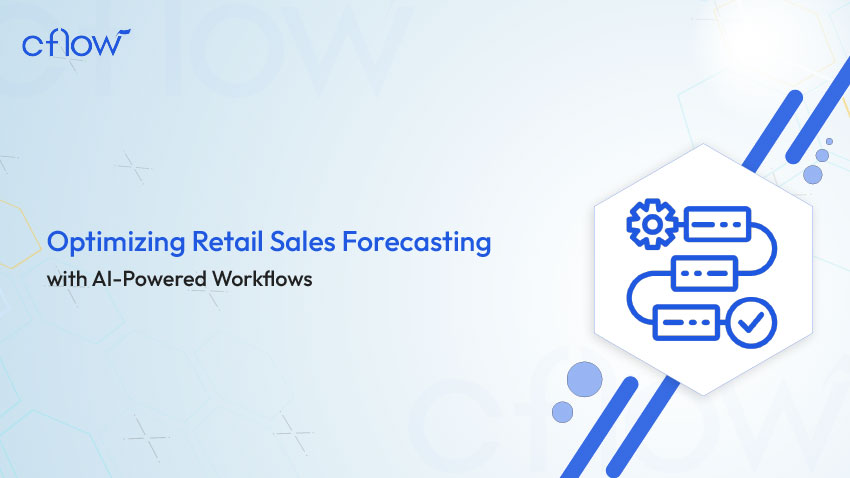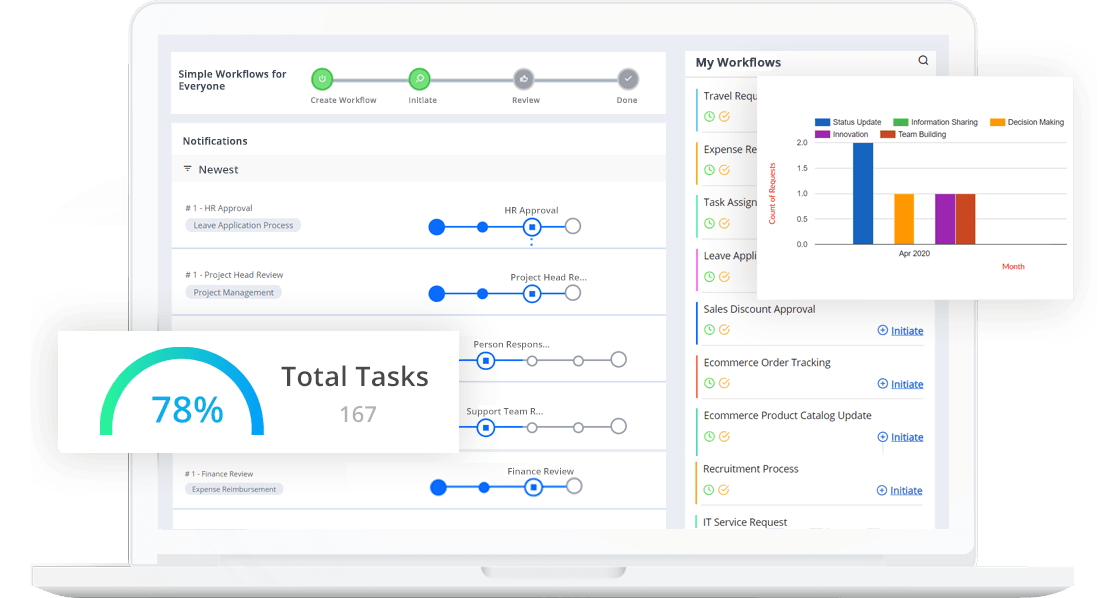Optimizing Retail Sales Forecasting with AI-Powered Workflows

Key takeaways
- Retail sales forecasting helps businesses predict future sales, manage inventory, and optimize pricing strategies based on historical data and market trends.
- Traditional forecasting methods rely on historical data and manual processes, making them less adaptable to sudden market changes.
- AI-powered forecasting enhances accuracy by integrating real-time data from sources like customer behavior, social media trends, and economic indicators.
- Leading retailers like Levi Strauss & Co. and Bimbo Bakeries have successfully leveraged AI-powered forecasting to optimize inventory management and drive profitability.
Introduction
Retail businesses are constantly challenged by fluctuating consumer demand, economic shifts, and ever-changing market conditions. Accurate retail sales forecasting is critical for managing inventory, optimizing pricing strategies, and ensuring profitability. However, traditional forecasting methods—heavily reliant on historical sales data and manual processes—struggle to keep up with today’s fast-paced retail environment.
Unlike traditional forecasting methods that rely on static data, AI-powered retail sales forecasting integrates real-time insights from multiple sources—social media trends, customer behavior, economic indicators, and even weather patterns—to provide highly accurate and adaptable predictions. The result? Retailers can prevent stockouts, reduce overstocking, and dynamically adjust pricing for maximum profitability.
The AI in the retail market in North America was valued at approximately $4.73 billion in 2024 and is projected to expand at a compound annual growth rate (CAGR) of 18.16% during the forecast period.
In this blog, we’ll explore the challenges of traditional retail sales forecasting, the advantages of AI-driven forecasting, and real-world case studies that showcase how AI is revolutionizing retail decision-making. Whether you’re a retail manager, supply chain expert, or business owner, understanding AI-powered forecasting is key to staying ahead in an increasingly competitive market.
Table of Contents
What is AI-Powered Retail Forecasting?
AI-powered retail forecasting is the use of artificial intelligence and machine learning to predict future sales, demand, and inventory needs based on real-time and historical data. It helps retailers improve accuracy, optimize stock levels, and enhance pricing and promotional strategies.
Unlike traditional forecasting, AI-driven models analyze complex patterns from customer behavior, market trends, and external factors like weather or economic shifts. This enables businesses to make data-driven decisions, reduce stockouts, and increase efficiency.
For example, a supermarket chain may use AI to predict demand for fresh produce by analyzing sales trends, regional preferences, and climate conditions, ensuring optimal inventory management.
AI-driven forecasting can reduce supply chain errors by 20% to 50%, leading to a 65% boost in efficiency through fewer lost sales and improved product availability.
The Challenges of Traditional Retail Sales Forecasting
Retailers have long relied on historical sales data, seasonal trends, and manual analytics to predict future sales. However, these traditional methods pose several challenges:
1. Lack of Real-Time Insights
Conventional forecasting methods depend heavily on past data, making it difficult to adjust predictions based on real-time changes in customer behavior and market trends.
2. Demand Volatility
Consumer preferences, economic conditions, and unforeseen events like pandemics can drastically shift demand patterns, making static forecasting models unreliable.
3. Inventory Imbalance
Overestimating demand leads to overstocking, increasing holding costs, while underestimating demand results in stockouts, frustrating customers, and losing sales.
4. Manual Processing Errors
Traditional forecasting involves manual data entry and spreadsheet calculations, increasing the risk of human errors and inaccurate predictions.
5. Inefficient Pricing Strategies
Without accurate demand predictions, retailers struggle to implement dynamic pricing strategies, missing opportunities to maximize profits.
Traditional Retail Sales Forecasting and AI-Powered Sales Forecasting
Here’s a detailed comparison between Traditional Retail Sales Forecasting and AI-Powered Sales Forecasting, highlighting their key differences, advantages, and limitations.
| Aspect | Traditional Retail Sales Forecasting | AI-Powered Sales Forecasting |
|---|---|---|
| Data Sources | Historical sales data, seasonal trends, and expert judgment | Historical data + real-time market trends, social media, weather, economic indicators, and customer behavior |
| Accuracy | Lower accuracy due to reliance on static data and assumptions | Higher accuracy as AI learns patterns and adapts to real-time changes |
| Speed of Analysis | Manual process, slow, and time-consuming | Automated and real-time forecasting |
| Adaptability | Struggles to adjust to sudden market changes | Quickly adapts to new trends and anomalies |
| Complexity of Variables | Limited to a few known factors | Can analyze multiple variables simultaneously |
| Human Intervention | High dependence on human judgment | Minimal human intervention required |
| Scalability | Hard to scale for large data volumes | Easily scales with big data capabilities |
| Cost Efficiency | Higher long-term costs due to labor-intensive processes | Lower operational costs with automation |
| Predictive Insights | Basic trends, often reactive | Advanced predictive analytics with deep learning models |
| Decision Making | Requires manual interpretation of data | Provides actionable insights with minimal effort |
| Handling Uncertainty | Struggles with unexpected market shifts | Can model and simulate multiple scenarios |
| Personalization | Limited ability to tailor insights to specific customers | Can deliver personalized recommendations and forecasts |
| Implementation Time | Requires extensive manual setup | Quick deployment with AI-driven tools |
Benefits of AI-Powered Retail Sales Forecasting
Below are some key benefits of AI-powered retail sales forecasting that help businesses enhance accuracy, optimize resources, and drive profitability.
1. Higher Forecast Accuracy
AI processes vast data sets to predict demand accurately, reducing overstocking and stockouts. This ensures better inventory control and sales planning. AI-driven forecasting can reduce supply chain errors by 20% to 50%, leading to a 65% boost in efficiency.
2. Real-Time Market Insights
AI continuously tracks customer behavior and market trends, allowing retailers to adapt quickly. This helps optimize pricing, promotions, and stock levels. AI continuously processes market trends and customer behavior, enabling retailers to adapt quickly.
For instance, AI-influenced shopping contributed to $229 billion in global sales during the 2024 holiday season.
3. Optimized Inventory Management
Predictive analytics prevents inventory shortages and excess stock. AI helps retailers maintain the right stock levels, reducing costs and improving availability. Companies like Danone have achieved a 30% reduction in lost sales through AI-powered demand models.
4. Dynamic Pricing Optimization
AI-driven pricing adjusts based on demand, competitor pricing, and buying patterns. This maximizes revenue while keeping products competitively priced. Retailers employing AI for dynamic pricing have seen significant improvements in profitability and customer satisfaction.
5. Reduced Waste & Costs
AI forecasts minimize product wastage, especially for perishable goods. Efficient stock management leads to lower operational costs and higher profitability.
6. Personalized Customer Experience
AI tailors promotions and product recommendations based on customer preferences. This personalization has been shown to increase engagement and sales conversions.
How AI-Powered Workflows Optimize Retail Sales Forecasting
Retail businesses thrive on accurate sales forecasting to optimize inventory, reduce costs, and maximize profitability. AI-powered workflows enhance forecasting accuracy by leveraging real-time data, machine learning models, and automation. Below, we explore how AI-driven workflows optimize retail sales forecasting across multiple dimensions.
1. Advanced Data Collection and Integration
Traditional forecasting methods often rely on limited historical sales data, leading to inaccurate predictions. AI-powered forecasting integrates data from multiple sources for a more comprehensive understanding of sales trends:
- Point-of-Sale (POS) Systems – Captures real-time transaction data, providing immediate insights into product demand.
- Customer Relationship Management (CRM) Tools – Tracks customer preferences, behaviors, and past purchases to anticipate future buying patterns.
- Omnichannel Sales Tracking – Analyzes both online and offline transactions, ensuring a unified view of customer behavior across all touchpoints.
- External Market Factors – Incorporates data such as economic trends, weather patterns, competitor pricing, and consumer sentiment analysis to refine demand forecasting.
By aggregating diverse data sources, AI-powered workflows enhance the accuracy and reliability of sales predictions, enabling retailers to respond proactively to changing demand.
2. Machine Learning for Demand Prediction
Traditional sales forecasting models rely on static formulas that often fail to adapt to real-time changes. AI-driven machine learning (ML) algorithms continuously refine predictions by analyzing vast datasets and identifying hidden patterns. Key advantages include:
- Higher Accuracy in Demand Forecasting – ML models process both historical and real-time data to detect demand fluctuations and predict future trends with precision.
- Adaptability to Market Disruptions – AI dynamically adjusts forecasts in response to supply chain disruptions, economic shifts, and sudden consumer behavior changes.
- Regional Demand Sensitivity – ML algorithms detect variations in demand across different locations, allowing retailers to adjust inventory distribution accordingly.
For example, an AI-powered forecasting system can detect a spike in winter clothing sales in certain regions and adjust shipments to prevent stockouts while avoiding overstock in less affected areas.
3. Automation in Forecasting Workflows
Retail sales forecasting often involves repetitive and time-consuming tasks such as data collection, report generation, and analysis. AI automates these workflows to streamline forecasting:
- Real-Time Data Processing – AI-driven workflows continuously update forecasts based on live data, allowing for more responsive decision-making.
- Elimination of Human Errors – Automated calculations reduce the risk of errors associated with manual data entry and spreadsheet-based forecasting.
- Scalability for Large Data Sets – AI-driven forecasting tools can process massive amounts of sales data effortlessly, making them ideal for large-scale retailers.
By automating the forecasting process, retailers can focus more on strategy and execution rather than spending time on data analysis.
4. AI-Driven Inventory Optimization
Accurate forecasting is essential for effective inventory management. AI-powered workflows help retailers maintain optimal stock levels by:
- Preventing Overstocking – AI forecasts demand fluctuations and ensures inventory aligns with actual sales patterns, reducing storage costs and markdown losses.
- Minimizing Stockouts – Predictive analytics alert retailers when a product is likely to run out, prompting timely reorders to maintain availability.
- Improving Procurement Planning – AI-driven insights optimize order quantities and supplier coordination, leading to cost-efficient supply chain operations.
Retailers leveraging AI for inventory management report up to a 30% reduction in inventory costs, along with improved fulfillment rates and customer satisfaction.
5. Dynamic Pricing and Promotion Strategies
AI-driven forecasting enables retailers to optimize pricing strategies and promotional campaigns through data-driven insights. Key benefits include:
- Real-Time Price Adjustments – AI analyzes competitor pricing, customer demand, and economic factors to adjust prices dynamically, maximizing revenue potential.
- Personalized Promotions – AI identifies customer preferences and purchase history to offer targeted discounts and promotions, enhancing engagement and conversions.
- Profit Margin Optimization – AI ensures that discounting strategies are profitable by analyzing real-time demand elasticity.
For instance, AI-powered tools can suggest discounts for slow-moving inventory while maintaining premium pricing for high-demand products, balancing sales volume and profitability.
6. Enhancing Customer Experience with AI
AI-powered sales forecasting isn’t just about numbers—it directly impacts the shopping experience by ensuring customers find what they need when they need it. AI enhances customer experience by:
- Personalized Product Recommendations – AI suggests relevant products based on past purchases and browsing behavior, increasing upselling and cross-selling opportunities.
- Better Stock Availability – Accurate demand predictions prevent stock shortages, reducing the frustration of customers finding items out of stock.
- Proactive Customer Engagement – AI-driven insights enable retailers to send timely and personalized marketing messages based on customer behavior and predicted needs.
How to implement AI-powered workflows in sales forecasting
Implementing AI-powered workflows in sales forecasting involves integrating machine learning algorithms and automation to enhance predictive accuracy and efficiency. Here’s a step-by-step guide to implementing AI-driven workflows in sales forecasting:
1. Define Business Objectives
Start by identifying key sales forecasting goals, such as demand prediction, inventory optimization, or revenue projections. Align AI implementation with these objectives to ensure maximum impact.
2. Collect and Organize Data
AI models require high-quality data to generate accurate forecasts. Gather historical sales data, market trends, customer behavior, and external factors like economic conditions. Clean and structure the data for analysis.
3. Choose the Right AI Tools and Platforms
Select AI-powered forecasting tools or platforms that align with your business needs. Solutions like Cflow, Salesforce Einstein Analytics, and IBM Watson offer automation and predictive capabilities tailored for sales forecasting.
4. Implement Machine Learning Models
Train AI models using historical data and relevant variables. Leverage machine learning techniques such as time series analysis, regression models, and deep learning to refine forecasting accuracy over time.
5. Automate Forecasting Workflows
Use AI to automate data collection, processing, and reporting. Workflow automation platforms can streamline tasks such as demand analysis, order predictions, and real-time adjustments based on changing sales patterns.
6. Integrate AI with Sales and ERP Systems
Seamlessly connect AI-powered forecasting tools with CRM, ERP, and inventory management systems to enhance real-time decision-making and automate sales operations.
7. Continuously Monitor and Improve
Regularly evaluate forecasting accuracy, identify areas for improvement, and retrain AI models with updated data. Continuous monitoring helps refine predictions and adapt to market changes.
End-to-end workflow automation
Build fully-customizable, no code process workflows in a jiffy.
Real-World Case Studies: AI-Powered Forecasting in Retail Workflows
By integrating AI into forecasting workflows, retailers can automate data analysis, predict trends, and optimize supply chain operations in real time. Here are some real-world examples of how leading companies leverage AI-driven forecasting to enhance their retail workflows.
1. Fashion Industry: Levi Strauss & Co.
Levi Strauss & Co. partnered with Google Cloud to centralize and analyze data from global sales, website traffic, and retail partners. Their AI-powered forecasting models identified a growing trend in baggy jeans across different demographics.
With this insight, Levi’s automated inventory allocation workflows to ensure stores were stocked with trending products, optimized design cycles based on predictive analytics, and executed data-driven marketing campaigns. This workflow automation reduced inventory misalignment and enhanced consumer satisfaction.
2. Supermarket Sector: Marks & Spencer
Marks & Spencer implemented an AI-powered recommendation engine called the “Wine Finder” to personalize the shopping experience. By analyzing customer inputs and purchase history, the AI tool suggested suitable wines, streamlining decision-making for customers.
Behind the scenes, this system was integrated with automated stock replenishment workflows, helping M&S optimize inventory levels based on forecasted demand patterns. As a result, they improved stock turnover and minimized overstocking or stockouts.
3. Consumer Goods: Bimbo Bakeries USA
Bimbo Bakeries USA leveraged AI-driven demand forecasting to enhance automated sales and inventory workflows. Machine learning algorithms processed historical sales data, weather patterns, and regional demand variations to predict sales fluctuations more accurately. This reduced forecast errors by up to 30%, allowing the company to automate inventory adjustments, optimize distribution schedules, and minimize waste.
By embedding AI into their supply chain workflows, Bimbo Bakeries improved efficiency while ensuring product availability aligned with market demand.
How Cflow Optimizes Retail Sales Forecasting with AI-Powered Workflows
Cflow is a versatile no-code workflow automation platform that streamlines business processes across industries, including retail. Cflow’s automation capabilities can significantly enhance sales forecasting, inventory management, and decision-making in the retail sector.
By integrating AI-driven workflows, Cflow helps retailers optimize demand predictions, reduce stock discrepancies, and improve overall operational efficiency. Here’s how Cflow supports retail sales forecasting:
1. Visual Workflow Builder
Cflow’s drag-and-drop builder lets businesses design and automate workflows without coding, making process management seamless.
2. Drag-and-Drop Form Designer
Users can create custom forms with various field types, streamlining data collection and enhancing automation.
3. OCR for Data Extraction
Cflow’s OCR technology extracts text and data from documents automatically, reducing manual entry and improving accuracy.
4. Role-Based Access Control (RBAC)
Admins can assign user roles and permissions, ensuring secure workflow access and maintaining data integrity.
5. Kanban Boards
A visual workflow tool that simplifies task tracking and improves efficiency by allowing seamless movement of tasks.
6. Mobile Accessibility
Users can access workflows anytime, anywhere, enabling remote teams to manage approvals and track progress efficiently.
Conclusion
AI-powered retail sales forecasting enables businesses to predict demand more accurately, optimize inventory, and adjust pricing strategies in real time. By integrating machine learning and automation, retailers can respond quickly to market fluctuations and improve operational efficiency. Adopting workflow automation solutions like Cflow helps streamline forecasting processes and enhance decision-making for sustainable growth.
Explore how Cflow can streamline your retail forecasting—get started today with a free trial!
FAQs
1. How does AI improve retail sales forecasting accuracy?
AI analyzes historical sales data, market trends, and customer behavior to predict demand with high accuracy. It adapts in real-time, reducing errors from seasonality and demand fluctuations.
2. What are the key benefits of AI-powered sales forecasting?
AI enhances demand accuracy, reduces stockouts, optimizes inventory, and improves pricing strategies. It also enables data-driven decisions for better profitability and customer satisfaction.
3. How can retailers implement AI-powered workflows for forecasting?
Retailers can integrate AI tools with existing systems, automate data collection, and use machine learning models for real-time demand forecasting and inventory planning.
What should you do next?
Thanks for reading till the end. Here are 3 ways we can help you automate your business:

Do better workflow automation with Cflow
Create workflows with multiple steps, parallel reviewals. auto approvals, public forms, etc. to save time and cost.

Talk to a workflow expert
Get a 30-min. free consultation with our Workflow expert to optimize your daily tasks.

Get smarter with our workflow resources
Explore our workflow automation blogs, ebooks, and other resources to master workflow automation.
What would you like to do next?
Automate your workflows with our Cflow experts.



